
The Sinai Peninsula, or simply Sinai, is a peninsula in Egypt, and the only part of the country located in Asia. It is between the Mediterranean Sea to the north and the Red Sea to the south, and is a land bridge between Asia and Africa. Sinai has a land area of about 60,000 km2 (23,000 sq mi) and a population of approximately 600,000 people. Administratively, the vast majority of the area of the Sinai Peninsula is divided into two governorates: the South Sinai Governorate and the North Sinai Governorate. Three other governorates span the Suez Canal, crossing into African Egypt: Suez Governorate on the southern end of the Suez Canal, Ismailia Governorate in the center, and Port Said Governorate in the north.

Muhammad Anwar es-Sadat was an Egyptian politician and military officer who served as the third president of Egypt, from 15 October 1970 until his assassination by fundamentalist army officers on 6 October 1981. Sadat was a senior member of the Free Officers who overthrew King Farouk in the Egyptian Revolution of 1952, and a close confidant of President Gamal Abdel Nasser, under whom he served as Vice President twice and whom he succeeded as president in 1970. In 1978, Sadat and Menachem Begin, Prime Minister of Israel, signed a peace treaty in cooperation with United States President Jimmy Carter, for which they were recognized with the Nobel Peace Prize.

Mount Sinai, also known as Jabal Musa, is a mountain on the Sinai Peninsula of Egypt. It is one of several locations claimed to be the biblical Mount Sinai, the place where, according to the Torah, Bible, and Quran, Moses received the Ten Commandments.

The Camp David Accords were a pair of political agreements signed by Egyptian President Anwar Sadat and Israeli Prime Minister Menachem Begin on 17 September 1978, following twelve days of secret negotiations at Camp David, the country retreat of the President of the United States in Maryland. The two framework agreements were signed at the White House and were witnessed by President Jimmy Carter. The second of these frameworks led directly to the 1979 Egypt–Israel peace treaty. Due to the agreement, Sadat and Begin received the shared 1978 Nobel Peace Prize. The first framework, which dealt with the Palestinian territories, was written without participation of the Palestinians and was condemned by the United Nations.

The Egypt–Israel peace treaty was signed in Washington, D.C., United States, on 26 March 1979, following the 1978 Camp David Accords. The Egypt–Israel treaty was signed by Anwar Sadat, President of Egypt, and Menachem Begin, Prime Minister of Israel, and witnessed by Jimmy Carter, President of the United States.
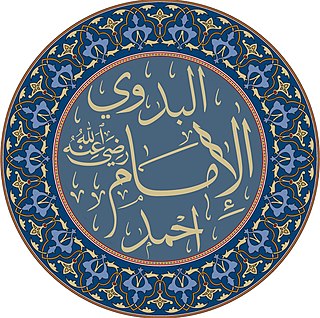
Aḥmad al-Badawī, also known as Al-Sayyid al-Badawī, or as al-Badawī for short, or reverentially as Shaykh al-Badawī by Sunni Muslims who venerate saints, was a 13th-century Arab Sufi Muslim mystic who became famous as the founder of the Badawiyyah order of Sufism. Born in Fes, Morocco to a Bedouin tribe originally from the Syrian Desert, al-Badawi eventually settled for good in Tanta, Egypt in 1236, whence he developed a posthumous reputation as "One of the greatest saints in the Arab world" As al-Badawi is perhaps "the most popular of Muslim saints in Egypt", his tomb has remained a "major site of visitation" for Muslims in the region.

El Tor, also romanized as Al-Tur and At-Tur and known as Tur Sinai, formerly Raithu, is a small city and the capital of the South Sinai Governorate of Egypt. The name of the city comes from the Arabic term for the mountain where the prophet Moses is believed to have received the Tablets of the Law from God; this mountain is designated Jabal Al Tor.
Ofira, is an Egyptian neighborhood that was previously an Israeli settlement in the Sharm el-Sheikh area of the southern Sinai Peninsula, an Egyptian territory that was under Israeli occupation from 1967 to 1982. Ofira was settled from 1969 and was meant to accommodate 500 families. An airfield was opened in 1976, today known as Sharm el-Sheikh International Airport.
Articles related to Modern Egypt include:
Hassan Tuhami (1924–2009) was an Egyptian deputy prime minister during Anwar Sadat's presidency. He also held various posts during the presidency of Gamal Abdel Nasser, including ambassador of Egypt to Austria and director general of the Arab Socialist Union.
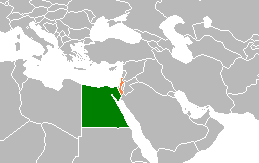
Egypt–Israel relations are foreign relations between Egypt and Israel. The state of war between both countries which dated back to the 1948 Arab–Israeli War culminated in the Yom Kippur War in 1973, and was followed by the 1979 Egypt–Israel peace treaty a year after the Camp David Accords, mediated by U.S. president Jimmy Carter. Full diplomatic relations were established on January 26, 1980, and the formal exchange of ambassadors took place one month later, on February 26, 1980, with Eliyahu Ben-Elissar serving as the first Israeli Ambassador to Egypt, and Saad Mortada as the first Egyptian Ambassador to Israel. Egypt has an embassy in Tel Aviv and a consulate in Eilat. Israel has an embassy in Cairo and a consulate in Alexandria. Their shared border has two official crossings, one at Taba and one at Nitzana. The crossing at Nitzana is for commercial and tourist traffic only. The two countries' borders also meet at the shoreline of the Gulf of Aqaba in the Red Sea.
The History of Republican Egypt spans the period of modern Egyptian history from the Egyptian Revolution of 1952 to the present day, which saw the toppling of the monarchy of Egypt and Sudan, the establishment of a presidential republic, and a period of profound economic, and political change in Egypt, and throughout the Arab world. The abolition of a monarchy and aristocracy viewed widely as sympathetic to Western interests, particularly since the ousting of Khedive Isma'il Pasha, over seven decades earlier, helped strengthen the authentically Egyptian character of the republic in the eyes of its supporters.

Saint Catherine is a town in the South Sinai Governorate of Egypt, situated at the foot of Mount Sinai. The city is the site of Saint Catherine's Monastery.
The Arab Cold War was a political rivalry in the Arab world from the early 1950s to the late 1970s, as part of the wider Cold War. It is generally accepted that the beginning of the Arab Cold War is marked by the Egyptian revolution of 1952, which eventually led to Gamal Abdel Nasser becoming president of Egypt in 1956. Thereafter, newly formed Arab republics, defined by revolutionary secular nationalism and inspired by Nasser's Egypt, engaged in political rivalries with conservative traditionalist Arab monarchies, led by Saudi Arabia. The Iranian Revolution of 1979 is widely seen as the end of this period of internal conflict and rivalry. Ayatollah Ruhollah Khomeini was installed as the leader of Iran's theocratic government. A new era of Arab-Iranian tensions followed, overshadowing the bitterness of intra-Arab strife.
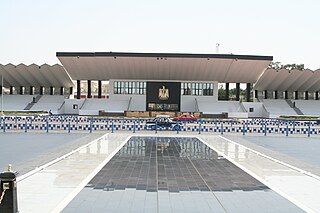
Anwar Sadat, the 3rd President of Egypt, was assassinated on 6 October 1981 during the annual victory parade held in Cairo to celebrate Operation Badr, during which the Egyptian Army had crossed the Suez Canal and taken back the Sinai Peninsula from Israel at the beginning of the Yom Kippur War. The assassination was undertaken by members of the Egyptian Islamic Jihad.

The history of Egypt under Anwar Sadat covers the eleven year period of Egyptian history from Anwar Sadat's election as President of Egypt on 15 October 1970, following the death of President Gamal Abdel Nasser, to Sadat's assassination by Islamist fundamentalist army officers on 6 October 1981. Though presenting himself as a Nasserist during his predecessor's lifetime, upon becoming President, Sadat broke with many of the core tenets of the domestic and foreign policy ideology that had defined Egyptian politics since the Egyptian Revolution of 1952. In addition to abandoning many of Nasser's economic and political principles via the Infitah policy, Sadat ended Egypt's strategic partnership with the Soviet Union in favor of a new strategic relationship with the United States, initiated the peace process with the State of Israel in exchange for the evacuation of all Israeli military forces and settlers from Egyptian territory, and instituted a form of politics in Egypt that, whilst far removed from Egypt's pre-revolution democratic system, allowed for some multi-party representation in Egyptian politics. Sadat's tenure also witnessed a rise in governmental corruption, and a widening of the gulf between rich and poor, both of which would become hallmarks of the presidency of his successor, Hosni Mubarak.

The Corrective Revolution was a reform program launched on 15 May 1971 by President Anwar Sadat. It involved purging Nasserist members of the government and security forces, often considered pro-Soviet and left-wing, and drumming up popular support by presenting the takeover as a continuation of the Egyptian Revolution of 1952, while at the same time radically changing track on issues of foreign policy, economy, and ideology. This includes a large shift in Egyptian diplomacy, building ties to the United States and Israel, while breaking from the USSR and, after signing the Egyptian-Israeli Peace Treaty, Egypt's subsequent suspension from the Arab League.

The Angel is an Israeli spy thriller film directed by Ariel Vromen and starring Marwan Kenzari and Toby Kebbell among others. It is an adaptation of the non-fiction book The Angel: The Egyptian Spy Who Saved Israel written by Uri Bar-Joseph. It is a fictional account of Ashraf Marwan, a high-ranking Egyptian official who became a double agent for both countries and helped achieve peace between the two.
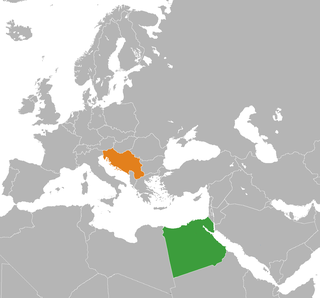
Egypt–Yugoslavia relations were historical foreign relations between Egypt and now break-up Yugoslavia. Both countries were founding members and prominent participants of the Non-Aligned Movement. While initially marginal, relations between the two Mediterranean countries developed significantly in the aftermath of the Soviet-Yugoslav split of 1948 and the Egyptian revolution of 1952. Belgrade hosted the Non-Aligned movement's first conference for which preparatory meeting took place in Cairo, while Cairo hosted the second conference. While critical of certain aspects of the Camp David Accords Yugoslavia remained major advocate for Egyptian realist approach within the movement, and strongly opposed harsh criticism of Cairo or proposals which questioned country's place within the movement.
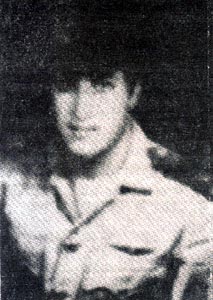
Mohamed Atef Anwar Sadat was a fighter pilot in the Egyptian Air Force who had the rank of flight lieutenant. In the Yom Kippur War, he and colleagues were killed in a raid on an Israeli military airport. He is the younger half brother of former Egyptian President Anwar Sadat, who was assassinated on the same day eight years later.



















